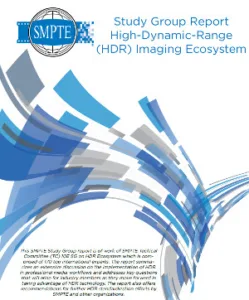The Society of Motion Picture and Television Engineers (SMPTE) has published a new study group (SG) report on the high-dynamic-range (HDR) imaging ecosystem. 170 top international experts contributed to the report, which summarizes an extensive discussion on the implementation of HDR in professional media workflows and addresses key questions that will arise for industry members as they move forward in taking advantage of HDR technology. The report also offers recommendations for further HDR standardization efforts by SMPTE and other organizations.
We talked with some of the report contributors about the effort at the SMPTE conference. What the report does NOT do is think about the consumer implementations of HDR via set top boxes, TVs, projectors, etc. Nor does it deal much with the details of distribution such as ways to encode the various HDR approaches, or how HDR signals need to be managed and distributed in professional production environments.
What is DOES do is provide a snap shot of the current thinking, issues, proposals and needs for the professional production community. This means capture, post production and finishing of HDR and Standard Dynamic Range (SDR) content in two basic forms: filed based for non-real time TV and movies and live TV.
Workflows for file-based HDR solutions exist today, but live solutions remain elusive. At the SMPTE event, there was much interest in the Hybrid Log Gamma (HLG) approach being championed by the BBC and NHK as a solution for live HDR.
The report provides a glossary of terms, but these should not be viewed as industry vetted definitions, I was told. The appendices detail the various HDR approaches from several companies, but these are short summaries provided by the companies with no additional commentary or recommendations. The report does not attempt to judge any technical issues – merely to inform.
The report seeks to provide basic information about HDR and provide a roadmap for future activities within SMPTE. The next step is for various SMPTE members to review the report and to form work groups to address identified needs, if there is consensus to do so. That could lead to engineering guidelines, best practices or standards.
“HDR is a rapidly emerging and much-debated technology with the capacity to make a greater impact on viewer experience than can higher-resolution formats,” said Alan Lambshead, vice president of standards for SMPTE. “Recognizing the remarkable potential of HDR and the media industry’s growing interest in this technology, SMPTE created an HDR ecosystem study group and — within just 12 months — delivered a valuable consensus report on implementation of HDR and the creation of efficient HDR workflows.”
SMPTE is actively working on the recommendations contained in the report and encourages industry participants to join the effort by contacting [email protected]. The report is available for download at https://www.smpte.org/standards/reports.

